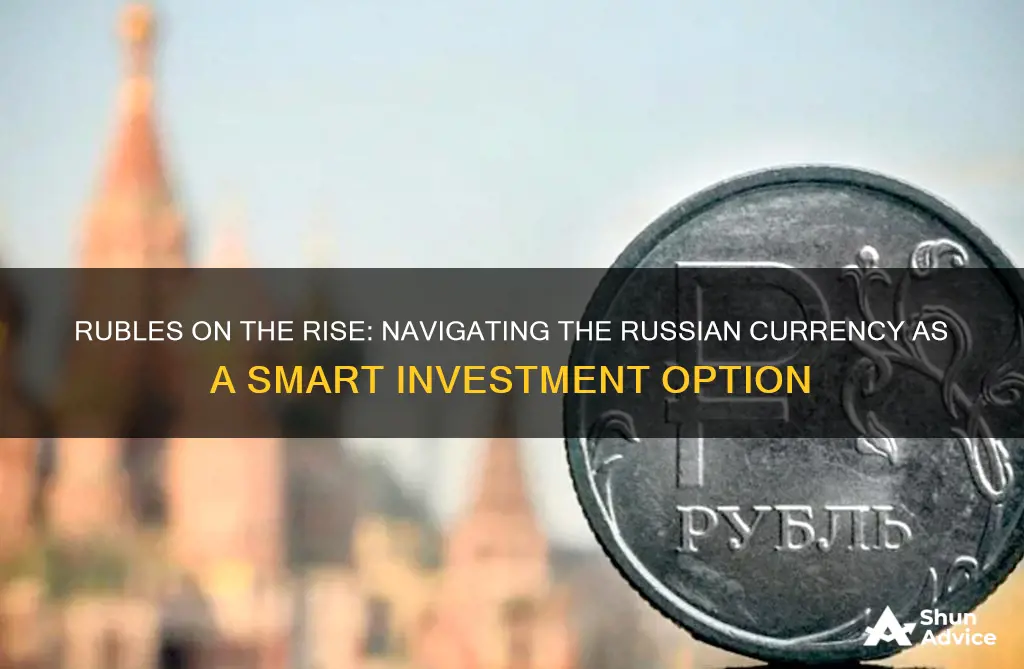
Since Russia's invasion of Ukraine, Western sanctions have hit the Russian ruble hard, causing its value to plummet. As a result, investors are divided between dumping the currency and buying the dip. If you're interested in investing in the Russian ruble, the clearest way to buy it is to exchange foreign currency for rubles within Russia at banks, hotels, and exchange bureaus. However, this option is limited to those eligible to enter the country. Outside of Russia, it has become increasingly difficult to buy rubles due to sanctions and the suspension of services by some money transfer providers.
| Characteristics | Values |
|---|---|
| Current value of the Russian ruble | Less than 1 US cent |
| How to buy rubles | Present foreign currency to banks, hotels, and exchange bureaus within Russian borders |
| How to buy rubles from outside Russia | Check for updates from high street banks and currency exchange providers |
| Other options | Transfer money from a debit or credit card to a Visa or Mastercard that works in Russia |
What You'll Learn

Where to buy Russian rubles
Since the sanctions placed on Russia, the ruble has become a very volatile currency and only a few countries now offer exchanges to and from the ruble. The clearest way to buy Russian rubles is to present foreign currency to banks, hotels, and exchange bureaus within Russian borders. This option is only available to those who are eligible to enter the country.
If you are looking to buy rubles from within the UK, Western Europe, or the United States, your best option is to check for updates from high street banks and currency exchange providers. Manor FX, for example, is a currency exchange bureau for purchasing Russian currency in the UK. They offer a straightforward process for acquiring rubles, with excellent rates and a seamless experience. You can order online and collect your rubles at their office near Heathrow, or opt for home delivery.
Investing in Yourself: Why the Fear?
You may want to see also

The impact of sanctions on the Russian ruble
Since Russia's invasion of Ukraine in February 2022, the country has been hit with multiple sanctions by the US, the EU, and their allies. These sanctions have had a significant impact on the Russian economy and, by extension, the Russian ruble.
One of the main goals of the sanctions was to cut Russia off from world financial markets and make it difficult for them to finance the war. This was done by preventing Western banks from transacting with key Russian banks and removing several Russian banks from the world interbank payment system. Additionally, the accounts of the Russian Central Bank denominated in allied currencies were frozen, rendering half of the bank's foreign exchange reserves unusable.
In response to these sanctions, the Russian Central Bank implemented strict capital controls and raised interest rates sharply. These actions helped stabilize the ruble and prevented a financial crisis in the short term. The ruble recovered to its pre-invasion level, trading at roughly 85 to the US dollar.
However, the long-term sustainability of these measures is uncertain. While Russia is a major exporter of oil and gas, which has provided an economic floor, the country's overall economy is expected to shrink. Russia's revenue from fossil fuels has also been impacted by sanctions on oil imports, with a significant drop in oil revenues in 2023 compared to the previous year.
The impact of the sanctions on the Russian ruble is complex. On the one hand, the ruble has recovered from its initial fall, which may indicate that the sanctions are not as effective as intended. On the other hand, the recovery could be attributed to Russia's efforts to artificially prop up its currency by leveraging its oil and gas sector.
Overall, the sanctions have created a challenging environment for investing in the Russian ruble. While some investors may see the potential for recovery and profit, there are also ethical considerations to take into account due to the ongoing conflict.
Invest Now: Where to Put Your Money
You may want to see also

The future of the Russian ruble
The Russian ruble has been subject to dramatic volatility since the country invaded Ukraine and the subsequent sanctions imposed by the West. The sanctions have severely impacted the ruble's value and Russia's financial system, making it a highly unattractive investment option.
However, some investors are considering the Russian ruble as a potential investment opportunity. Russia is a significant exporter of oil and farm produce, generating substantial profits. If investors believe that the ruble will recover, they may choose to buy it at a low price and sell it later when it gains value. On the other hand, if they anticipate a continued decline, short-selling the currency could be a profitable strategy.
The ruble's performance has been mixed, with a remarkable rebound on the Moscow Exchange, surpassing pre-conflict levels. This has been attributed to emergency capital controls and central bank rate hikes. However, the actual exchange rate experienced by individuals and businesses is often much worse, especially when trying to acquire foreign currency or purchase imported goods. The buying power of the ruble has been significantly eroded, with prices of goods, especially imported ones, soaring.
In conclusion, investing in the Russian ruble comes with significant risks and ethical considerations. While there is potential for profit, especially if the conflict ends and the ruble recovers, it may take years for the currency to regain its previous strength. The impact of sanctions and the erosion of purchasing power are critical factors that may influence the ruble's future trajectory.
Renting Out Your Home: A Guide to Turning Your Property into a Profitable Investment
You may want to see also

The ethical implications of investing in the Russian ruble
Investing in the Russian ruble comes with a set of ethical implications that investors should carefully consider. Since Russia's invasion of Ukraine, Western sanctions have significantly impacted the value of the ruble and the country's financial system. While some investors may see this as an opportunity to profit from the currency's potential recovery, there are ethical questions to contemplate.
Firstly, investing in the Russian ruble could be viewed as indirectly supporting Russia's economy and, by extension, its government. By providing capital and contributing to the demand for the currency, investors could be seen as aiding Russia's economic growth and stability. This becomes an ethical dilemma, especially for those who condemn Russia's actions in Ukraine.
Secondly, the potential profits from investing in the ruble could be perceived as "blood money." With the Russian economy suffering due to sanctions, investing in the ruble could be seen as profiting from the country's economic distress, which is partly a result of its military aggression. This raises questions about the morality of benefiting financially from a situation that has caused significant human suffering.
Thirdly, the volatility of the Russian ruble presents significant risks for investors. The value of the currency is influenced by external factors such as international trade and sanctions. With the ongoing conflict and sanctions in place, the ruble's value is highly uncertain and susceptible to sudden drops. Investing in such a volatile currency could be seen as a speculative bet on the country's economic and political future, which may have ethical implications if the investment decision is primarily driven by financial gain rather than a long-term commitment to Russia's economy.
Lastly, the impact of sanctions and Russia's response to them should be considered. Sanctions have restricted Russia's access to foreign accounts and the global financial system, limiting the country's ability to support the ruble's value. Russia's central bank, responsible for maintaining the currency's value, faces challenges due to these restrictions. Investing in the ruble while the country is under sanctions could be seen as going against the collective effort to hold Russia accountable for its actions.
In conclusion, while investing in the Russian ruble may present financial opportunities, it also carries ethical implications that investors should carefully evaluate. The potential for financial gain must be weighed against the moral considerations of supporting Russia's economy, profiting from a volatile currency, and the broader impact of investment decisions on the geopolitical landscape.
Popular Financial Assets to Invest In
You may want to see also

The history of the Russian ruble
The Russian ruble has a long history, dating back to the 13th century when it was first designated as a unit of silver weight. In 1704, Tsar Peter I (the Great) introduced the first regular minting of the ruble in silver. The ruble became a circulating coin just before the establishment of the Russian Empire and was the first currency in Europe to be decimalised, divided into 100 kopecks.
During the 18th century, the value of the silver ruble was debased, and from the mid-19th century onwards, Russia's circulation was dominated by rapidly depreciating paper money. In 1897, a gold standard was introduced, replacing silver rubles with gold ones. However, with the outbreak of World War I, gold coins disappeared from circulation, and notes became inconvertible. The Russian Revolution and civil war led to hyperinflation, rendering the ruble virtually worthless. A monetary reform between 1922 and 1923 reintroduced the chervonets as the standard unit, with the ruble serving as a unit of reckoning.
Following World War II, another reform in 1947 abolished the chervonets, restoring the ruble as the primary currency. During the Soviet era, the currency was known as the Soviet ruble, but after the collapse of the Soviet Union, it reverted to the Russian ruble. The Soviet ruble was replaced at par with the new Russian ruble, which was issued in 1993.
Since then, the ruble has undergone several incarnations and redenominations, the most recent being the introduction of the current Russian ruble (code: RUB) in 1998, exchanged at a rate of 1 RUB = 1,000 old rubles (RUR). The Russian ruble has experienced significant volatility, especially following the 2014 annexation of Crimea, the 2022 invasion of Ukraine, and the subsequent international sanctions.
As of 2024, the Russian ruble remains the currency of the Russian Federation and is the second-oldest currency still in circulation.
Silver Investment Strategies: A Guide to Buying and Storing Silver
You may want to see also
Frequently asked questions
The Russian Ruble is currently very weak against the dollar, so some investors believe that it will recover and they will be able to sell the currency for a profit in the future.
The most straightforward way to buy Russian Rubles is to exchange foreign currency at banks, hotels, and exchange bureaus within Russia. If you are looking to buy rubles from outside of Russia, you can occasionally check for updates from high street banks and currency exchange providers.
The Russian Ruble has become a very volatile currency due to the sanctions placed on Russia and the war with Ukraine. The currency could continue to lose value and may take a long time to recover, if it ever does.
Many people who condemn Russia's attack on Ukraine may see profits from the Ruble as blood money.
The Ruble was initially minted as a silver coin, and a gold Ruble was introduced at some point. During the Soviet era, the currency was called the Soviet Ruble, and after the collapse of the Soviet Union, it became the Russian Ruble again.







